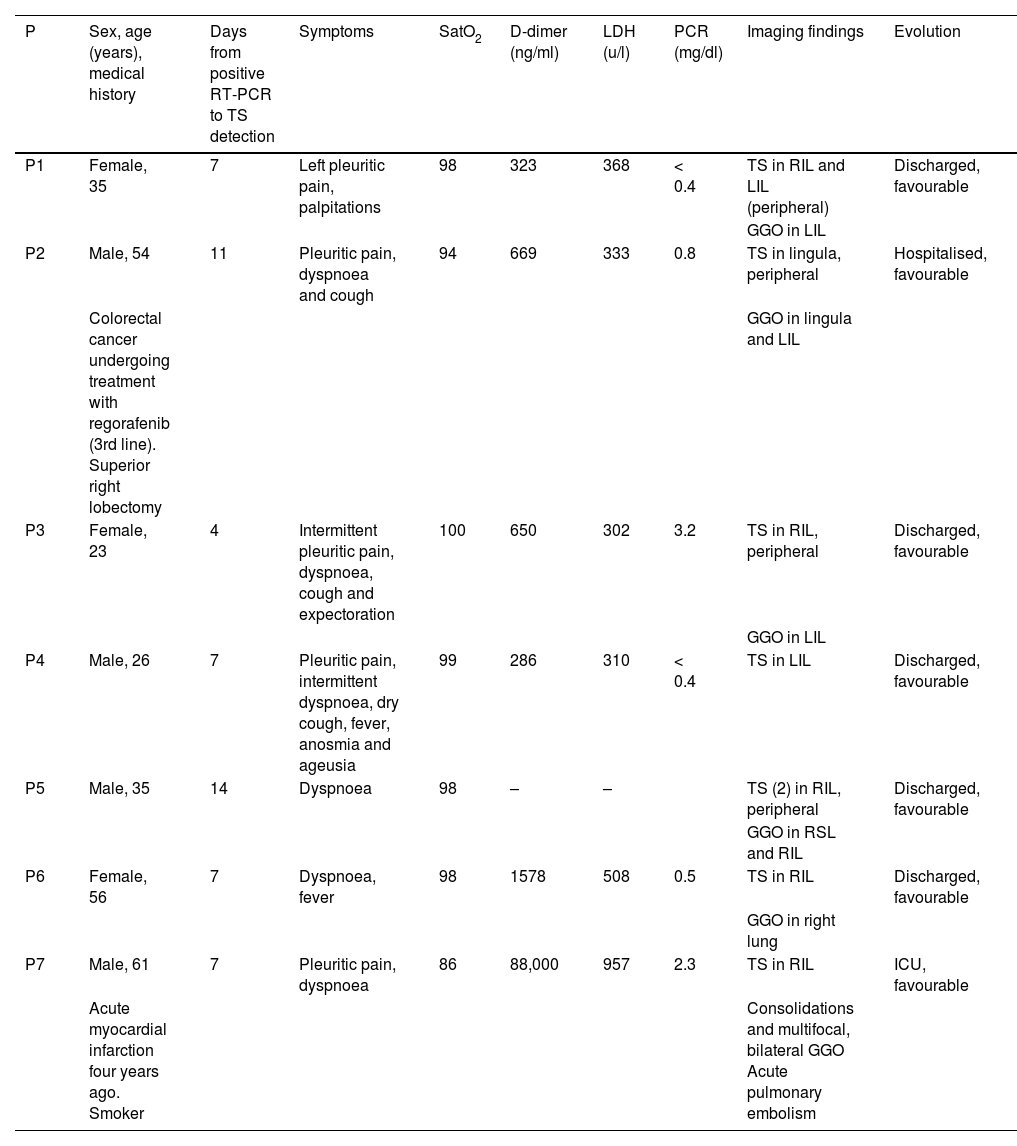
Suplement “"Advances in Thoracic Radiology”
More infoOur objectives are: To describe the radiological semiology, clinical-analytical features and prognosis related to the target sign (TS) in COVID-19. To determine whether digital thoracic tomosynthesis (DTT) improves the diagnostic ability of radiography.
Material and methodsRetrospective, descriptive, single-centre, case series study, accepted by our ethical committee. Radiological, clinical, analytical and follow-up characteristics of patients with COVID-19 and TS on radiography and DTT between November 2020 and January 2021 were analysed.
ResultsEleven TS were collected in 7 patients, median age 35 years, 57% male. All TS presented with a central nodule and a peripheral ring, and in at least 82%, the lung in between was of normal density. All TS were located in peripheral, basal regions and 91% in posterior regions. TS were multiple in 43%. Contiguous TS shared the peripheral ring. Other findings related to pneumonia were associated in 86% of patients. DTT detected 82% more TS than radiography. Only one patient underwent a CT angiography of the pulmonary arteries, positive for acute pulmonary thromboembolism. Seventy-one per cent presented with pleuritic pain. No distinctive laboratory findings or prognostic worsening were detected.
ConclusionsTS in COVID-19 predominates in peripheral and declining regions and can be multiple. Pulmonary thromboembolism was detected in one case. It occurs in young people, frequently with pleuritic pain and does not worsen the prognosis. DTT detects more than 80 % of TS than radiography.
Nuestros objetivos son describir la semiología radiológica, los datos distintivos clínico-analíticos y el pronóstico relacionados con el signo de la diana (SD) de la COVID-19. Determinar si la tomosíntesis digital torácica (TDT) mejora la capacidad diagnóstica de la radiografía.
Material y métodosEstudio retrospectivo, descriptivo de una serie de casos, unicéntrico, aceptado por nuestro comité ético. Se analizaron las características radiológicas, clínicas, analíticas y evolutivas de los pacientes con COVID-19 y SD en radiografía y TDT entre Noviembre 2020 y Enero 2021.
ResultadosSe recogieron 11 SD en 7 pacientes, con edad mediana de 35 años, 57% varones. Todos presentaron un nódulo central y un anillo periférico y, en al menos el 82%, el pulmón entre ambos fue de densidad normal. Todos se situaron en regiones periféricas, basales y el 91% en regiones posteriores. Fueron múltiples en un 43%. Los SD contiguos compartieron el anillo periférico. El 86% asoció otras manifestaciones pulmonares de neumonía. La TDT detectó un 82% más de SD que la radiografía. Solo en un paciente se realizó una angio-TC de arterias pulmonares, positiva para tromboembolia pulmonar aguda. El 71% acudió con dolor pleurítico. No se detectaron hallazgos analíticos distintivos ni empeoramiento pronóstico.
ConclusionesEl SD en la COVID-19 predomina en regiones periféricas y declive y puede ser múltiple, encontrando tromboembolia pulmonar en un caso. Se da en jóvenes, frecuentemente con dolor pleurítico y no empeora el pronóstico. La TDT detecta más del 80% de SD que la radiografía.











